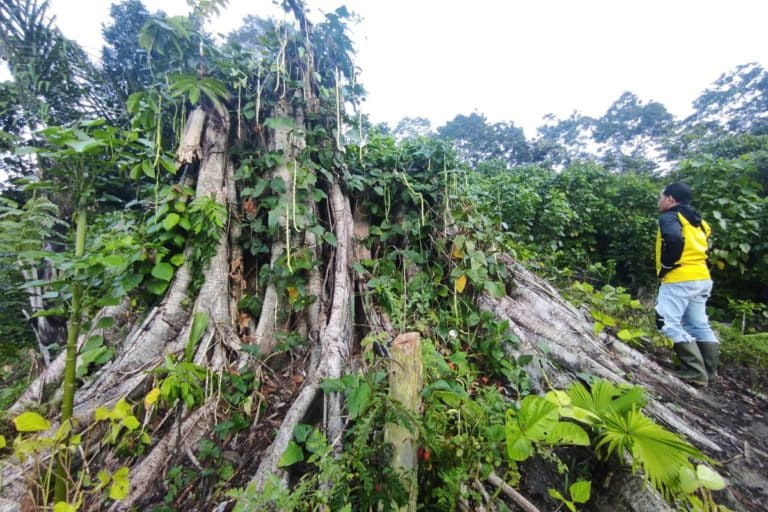- Ermi Mauke, 73, has spent the past 40 years planting a mix of trees on the fringe of Bogani Nani Wartabone National Park in eastern Indonesia’s Gorontalo province.
- Small farmers here have produced palm sugar for centuries using traditional techniques, but their labor-intensive methods face challenges.
- Ermi’s self-taught agroforestry system yields varied food commodities that help meet her family’s daily needs while safeguarding the landscape.
GORONTALO, Indonesia — In a Chanel-print dress and wielding a machete, Ermi Mauke means business as she hikes past cashew and coffee seedlings she planted on the approach to Indonesia’s Bogani Nani Wartabone National Park. Ermi has few problems ambling up these forested hills, even at the age of 73.
“Although I may be getting older, I still have the strength to climb mountains,” she tells Mongabay.
Ermi first began planting a mix of tree species in the Suwawa Mountains here in the Minahasa Peninsula on Indonesia’s Sulawesi Island 40 years ago. She began intercropping a wide range of seedlings, from avocado to candlenut and coffee, with the help of her family. This self-taught agroforestry system — the practice of planting multiple productive tree and crop species in a given landscape — has helped sustain both the ecosystem and her family’s daily needs.
Bogani Nani Wartabone is one of more than 50 national parks dotted among the world’s largest archipelagic country, which is home to the world’s third-largest tropical forest estate. The national park, which takes its name from a local independence fighter and politician, covers 282,000 hectares (700,000 acres) straddling the provinces of Gorontalo and North Sulawesi. Research in the forest has identified around 125 bird species and almost 300 distinct trees to date.
Ermi arrived in East Tulabolo village on the fringe of the protected forest in Bone Bolango district in 1982, as part of the government’s transmigration program, a centrally planned scheme to move millions of families from densely populated parts of the country to hinterlands like East Tulabolo to spark development.
Upon arrival 40 years ago from North Gorontalo district, Ermi found the forest around her new home had incurred widespread damage from illegal logging and gold mining, while many locals had staked claims to land in the forest area.

Near East Tulabolo village is a large, 25,000-hectare (62,000-acre) gold mine operated by PT Gorontalo Minerals, part of the politically connected Bakrie family conglomerate. The mining concession abuts onto the border of the national park, and a road to the site is currently under construction.
A 2019 study published in the journal Environment and Natural Resources Research documented the long-standing challenges faced by small farmers here. Most farmers living on the border of the park have relied for centuries on traditional techniques to produce palm sugar. However, this requires sourcing sufficient firewood to boil down the raw material gathered from sugar palms, a factor complicated by the establishment of the national park in 1991.
“We have difficulty finding firewood to cook palm sugar,” one local farmer told the study authors in 2018. “We used to take it in the forest, but now it’s not allowed because it’s guarded by national park officials.”
Data from Indonesia’s statistics agency showed 24.5% of Gorontalo’s rural population lived in poverty as of March 2021, more than double the national mean of 10.2%.
The forested area where Ermi lives serves as a buffer zone to the national park. Sustainable management of the East Tulabolo forest using Ermi’s agroforestry techniques offers a potential path to raising farmers’ incomes while curbing encroachment.
Studies in Indonesia have established that agroforestry can simultaneously improve the resilience of both the landscape and its local farming community.

Ermi often shares seedlings with neighbors and advocates the merits of planting fruit-bearing trees.
She tells Mongabay that her drive to nurture the land around the village came from her ancestors’ spiritual sense of responsibility to the land she calls home. Ermi said her parents taught her as a child that this forest was home for all species, not just for people.
“I didn’t go to school,” she said. “Taking care of the forest is what I do.”
This story was reported by Mongabay’s Indonesia team and first published here on our Indonesian site on April 24, 2022.
See related feature here at Mongabay:
Regenerative agriculture in Mexico boosts yields while restoring nature
